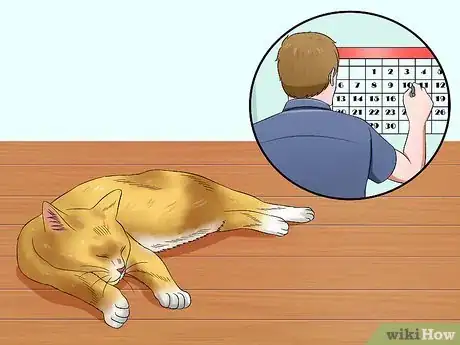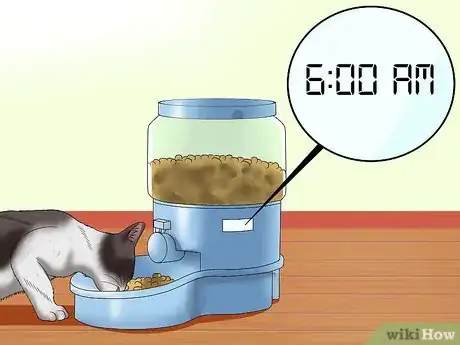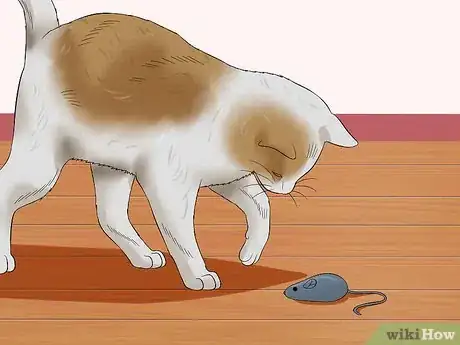This article was co-authored by Natalie Punt, DVM. Dr. Natalie Punt is a Veterinarian and the Founder and CEO of mPet- a smart phone app for pet owners to store, manage and transfer their pets medical records and health information. She specializes in small animal emergency and general medicine and veterinary practice economics. Dr. Punt holds a BS in Biochemistry and Molecular Biology from The University of California, Davis, an MS in Biochemistry from The University at Buffalo, and a DVM from Western University of Health Sciences.
There are 9 references cited in this article, which can be found at the bottom of the page.
wikiHow marks an article as reader-approved once it receives enough positive feedback. In this case, 100% of readers who voted found the article helpful, earning it our reader-approved status.
This article has been viewed 192,395 times.
Cats are known for sleeping long hours, and can snooze up to 16 hours a day. However, these hours of sleep do not happen in a row. Cats do not have daily sleep-wake cycles like many mammals. While they are not nocturnal, they are often up at odd hours during the night and this can cause disturbances for owners. If your cat is disrupting your sleep schedule, there are a variety of options to help get your cat to bed on time each night.
Steps
Setting Up a Schedule
-
1Set a sleep schedule and stick to it. Cats are like kids - they respond to schedules. Maintaining a routine is the first step to sleep training your cat.
- Establish a bedtime routine. Cats are social animals, and they crave attention and love from their owners. If possible, get up and go to bed at roughly the same time each night. This will help your cat adjust to your schedule, and they'll be more likely to rise and fall with you.
- Turn the lights off at a specific time. Darkness is a cue to cats that it's time to relax and cuddle up for bed.[1] However, keep in mind that cats also love to hunt at night, so darkness by itself doesn't make cats sleepy.
-
2Create the same environment every night. Cats thrive on schedule, and easily pick up on signs in regards to their owner's activities. If you sleep with the lights off, turn them off. If you turn the TV off at night, turn it off. If you turn on the fan, turn it on. If you listen to radio, listen to it. Create the same environment every time you go to bed. Your cat will recognize this environment, and understand that it's time to sleep.Advertisement
-
3Change how you feed your cat. When a cat is fed affects their sleep schedule drastically. Oftentimes, if a cat is being particularly pesky at bedtime or early morning they're simply hungry. If you can change how and when you feed your cat, this can lead to more peaceful nights.
- Try feeding your cat shortly before bed. We're all more likely to sleep after we've had a nice meal. Some people find that if you feed your cat a half cup of dry or wet food shortly before bedtime, they'll be more likely to sleep through the night full and satisfied.[2]
- Invest in an automatic feeder for morning meals. Automatic cat feeders, which can be set to release a handful of dry food at specific times, are available for purchase online and at many department stores and specialty pet stores. If your cat wakes you in the early hours of the morning wanting breakfast, an automatic feeder can help. Not to mention, cats are known for their sense of anticipation. If he knows breakfast is coming, he'll likely hang around the feeder early in the morning rather than making noise near the bedroom.
Entertaining Your Cat
-
1Schedule playtime before bed. Interactive play sessions in the evening are a great way to get your cat tired before bedtime.[3] Toys that mimic the movements of mice and birds, which cats hunt in the wild, are ideal options. Look for toys that bounce and wiggles, like ping-pong balls, string-based toys, and furry mouse toys. Play until your cat seems tired or uninterested. Cats hunt in short bursts, so they tire quickly (like sprinters, not marathon runners). They usually tire after 10 to 15 minutes max. However, make sure there's plenty of play spaced over the day.[4]
- Feathers and laser pointers are other great toys you can try.[5]
-
2Provide entertainment options for your cat throughout the day. Our pets lives revolve our comings and goings. Oftentimes, cats get bored during the day when their owners are gone. This leads to an excess of neediness later in the day, when you're trying to wind down and get to sleep. Keep your cat entertained while you're at work or school and they'll be less likely to need attention at night.
- Provide toys your cat can play with on his own. Small plush mice, especially those laced with catnip, are a great choice. They can be swatted around without a human's assistance. Make sure to rotate toys often as cats, like people, crave variety and will get bored with the same toy after awhile.[6]
- DVD's are available for purchase online and at some department stores that are designed specifically for cats. Video CatNip from Pet-A-Vision Inc., for example, includes footage of birds and mice that cats will try to catch when you're not home. Just leave the TV on and make sure it's at the cat's eye level.[7]
- Battery operated toys are available at most grocery stores, department stores, and supermarkets. These toys move on their own and can be left on for a few hours while you are at work. However, be sure to read any warning labels. Some battery operated toys recommend cats only use them with supervision.
- Give your kitty some catnip during the day! This can make them more energetic during that time.[8]
-
3Install a bird feeder. Cats love windows, and enjoy being able to see the outside world. Anything you can do to make your backyard more appealing is great. Installing a bird feeder is a low-cost way to give your cat something to watch while you're at home.
- Set up your feeder in a quiet place where it's easy to stock and refill. Feeders should ideally be close to natural shelters, like trees and shrubs, where birds will feel safe.
- Make sure your feeder is at least three feet away from your window. This reduces the likelihood of window collisions, which kill millions of birds each year.[9]
Setting up a Sleeping Space
-
1Leave your cat in a separate room. If possible, close your bedroom door at night. Cats are notoriously difficult to sleep with as they rarely sleep a full eight hours and can cause you physical harm via biting and scratching if they're startled by your movements during sleep. It's best to keep your cat out of the bedroom at night, and establish altogether that your sleeping space is not a cat-friendly area. Leave the door closed during the day as well. Cats are territorial. The more access they have with a particular space, the more they think of it as their own, and the harder it is to keep them out when you're trying to rest.
-
2Create a resting space for your cat. If your cat feels they have their own place to sleep, they're less likely to invade yours. Cats take refuge in comfortable spaces, surrounded by their toys, litter box, food, and bedding. Setting up a comfortable sleeping space for your cat can give him a place to go at night that won't interfere with your sleep.
- A high resting spot is ideal, as cats are natural observers and love to view a wide scope. A multi-level kitty condo, available for purchase online or at pet stores, can be a good option as it's comfortable for rest and also allows your cat to climb high.[10]
- Cats need multiple places to sleep, so provide them with multiple options. While many pet stores sell expensive bedding, just a pillow or blanket is usually sufficient. Place cat-friendly bedding throughout the house, and places where you are okay with your cat taking a snooze. Place a small pillow on the arm of your sofa, or a warm blanket on the top of the stairs. This signals to your cat that these are places for him to sleep.[11]
- Cats are most vulnerable when they are sleeping, so they prefer to rest in areas where they feel safe. Provide refuge in quiet spots of the house, especially places that are somewhat hidden like behind or under furniture.
- As stated, cats feel like a space is their own if their things are nearby. Set up resting spots close to your cat's food, water, litter, and toys so the cat knows this is a space for them.
-
3Keep deterrents by your bedroom door. If your cat keeps trying to get in at night, there are a variety of ways to deter this behavior. Set up some kind of inconvenience for your cat, or something that will startle him, and he'll be less likely to come to your door to cry and scratch.
- Place something in front of the door, such as vinyl carpet runner placed upside down to expose the knobby bits, double sided sticky tape, or aluminum foil. The unpleasant texture will make your cat less likely to bother you at night.
- Set up a booby trap to startle your cat. Hang your blowdryer from the doorknob or place your vacuum 5 or 6 feet (1.5 or 1.8 m) away from the door. Plug the dryer or vacuum into a remote switch, which can be purchased online or at a Radio Shack, and when your cat starts meowing or scratching turn the appliance on. The noise will startle your cat, and he'll be less likely to come back after that.[12]
Expert Q&A
-
QuestionWhat can I give my cat to fall asleep?
 Natalie Punt, DVMDr. Natalie Punt is a Veterinarian and the Founder and CEO of mPet- a smart phone app for pet owners to store, manage and transfer their pets medical records and health information. She specializes in small animal emergency and general medicine and veterinary practice economics. Dr. Punt holds a BS in Biochemistry and Molecular Biology from The University of California, Davis, an MS in Biochemistry from The University at Buffalo, and a DVM from Western University of Health Sciences.
Natalie Punt, DVMDr. Natalie Punt is a Veterinarian and the Founder and CEO of mPet- a smart phone app for pet owners to store, manage and transfer their pets medical records and health information. She specializes in small animal emergency and general medicine and veterinary practice economics. Dr. Punt holds a BS in Biochemistry and Molecular Biology from The University of California, Davis, an MS in Biochemistry from The University at Buffalo, and a DVM from Western University of Health Sciences.
Veterinarian Aside from medications, which should be prescribed by a veterinarian, you can try some calming sprays, like lavender.
Aside from medications, which should be prescribed by a veterinarian, you can try some calming sprays, like lavender. -
QuestionHow can I change my cat's sleep schedule?
 Natalie Punt, DVMDr. Natalie Punt is a Veterinarian and the Founder and CEO of mPet- a smart phone app for pet owners to store, manage and transfer their pets medical records and health information. She specializes in small animal emergency and general medicine and veterinary practice economics. Dr. Punt holds a BS in Biochemistry and Molecular Biology from The University of California, Davis, an MS in Biochemistry from The University at Buffalo, and a DVM from Western University of Health Sciences.
Natalie Punt, DVMDr. Natalie Punt is a Veterinarian and the Founder and CEO of mPet- a smart phone app for pet owners to store, manage and transfer their pets medical records and health information. She specializes in small animal emergency and general medicine and veterinary practice economics. Dr. Punt holds a BS in Biochemistry and Molecular Biology from The University of California, Davis, an MS in Biochemistry from The University at Buffalo, and a DVM from Western University of Health Sciences.
Veterinarian You can give them exercises and tire them out during the day, but remember that cats are considered nocturnal and trying to interfere with their normal behaviour may not be the best thing.
You can give them exercises and tire them out during the day, but remember that cats are considered nocturnal and trying to interfere with their normal behaviour may not be the best thing. -
QuestionMy 15 year old cat has matts on his back, but he gets angry when I try to tease them out. What can I do to help him?
 Pippa Elliott, MRCVSDr. Elliott, BVMS, MRCVS is a veterinarian with over 30 years of experience in veterinary surgery and companion animal practice. She graduated from the University of Glasgow in 1987 with a degree in veterinary medicine and surgery. She has worked at the same animal clinic in her hometown for over 20 years.
Pippa Elliott, MRCVSDr. Elliott, BVMS, MRCVS is a veterinarian with over 30 years of experience in veterinary surgery and companion animal practice. She graduated from the University of Glasgow in 1987 with a degree in veterinary medicine and surgery. She has worked at the same animal clinic in her hometown for over 20 years.
Veterinarian Many older cats are grumpy about removing knots because their joints are arthritic and they're worried about being hurt. If the knots are bad, speak to a friendly vet tech or groomer, who may be able to groom the knots out using a special tool and patience. For a short- haired cat introduce a rubber grooming tool or a deshedding brush as this removes shed hair and stops it building up. Use a comb on long-haired cats, but you may need to wait until the knots are gone before doing this.
Many older cats are grumpy about removing knots because their joints are arthritic and they're worried about being hurt. If the knots are bad, speak to a friendly vet tech or groomer, who may be able to groom the knots out using a special tool and patience. For a short- haired cat introduce a rubber grooming tool or a deshedding brush as this removes shed hair and stops it building up. Use a comb on long-haired cats, but you may need to wait until the knots are gone before doing this.
Warnings
- Cats are difficult to train as they do not respond to reward based training like dogs. Do not try scolding or caging your cat as a means of reinforcement. The cat will not understand the cause and effect relationship.⧼thumbs_response⧽
- Be sure to have a clean litter box available. Cats dislike using dirty litter, and if your cat keeps waking you up at night he might be having difficulty using the bathroom. Scoop out the litter box at least once a day.⧼thumbs_response⧽
- Do not feed cats milk or cream. While it is commonly believed cats love dairy products, the fact is many cats have trouble digesting lactose and this leads to diarrhea and other discomfort, both of which make it hard for a cat to sleep at night.[13]⧼thumbs_response⧽
References
- ↑ http://www.catster.com/lifestyle/5-tips-to-get-your-cat-to-let-you-sleep
- ↑ http://www.vetstreet.com/dr-marty-becker/how-can-we-get-our-cat-to-sleep-at-night
- ↑ Natalie Punt, DVM. Veterinarian. Expert Interview. 14 September 2021.
- ↑ http://pets.webmd.com/cats/guide/nighttime-activity-cats
- ↑ Natalie Punt, DVM. Veterinarian. Expert Interview. 14 September 2021.
- ↑ https://www.petfinder.com/cats/cat-problems/cat-calm-at-night/
- ↑ https://www.petfinder.com/cats/cat-problems/cat-calm-at-night/
- ↑ Natalie Punt, DVM. Veterinarian. Expert Interview. 14 September 2021.
- ↑ http://www.allaboutbirds.org/Page.aspx?pid=1182
About This Article
To help your cat sleep at bedtime, try feeding it shortly before you go to bed since cats are more likely to sleep on a full stomach. You can also play with your cat for 15-20 minutes before bed, which will tire it out. Also, make sure your cat has plenty of toys to entertain itself with when you're not at home so it doesn't sleep all day and then stay up all night. For more advice from our Veterinary co-author, like how to set up a sleeping space for your cat, scroll down!







































































